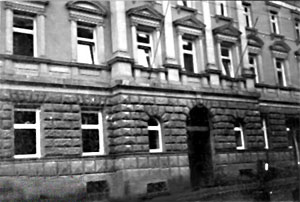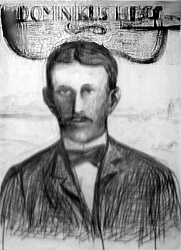|
 |
|
Staatgewerbeschule - (Innsbruck) |
When Hess is a young boy his father wants him to study the
violin but he feels no passion for music. Young Hess is
christened Alois, Anton, Dominikus; he likes none of his given
names. He changes Alois to Louis and as soon as he comes of age
he chooses a completely new name for himself. The family home is
full of musical instruments and Saturday evenings are a time for
all the family to make music together. To please his parents,
young Hess joins in - but his real passion is art. In one of his
early paintings, from 1908 - the year of his father's death at
the age of 42, the 13-year-old artist offers a portrait of the
family patriarch with a violin on his head: the physical
representation of the idée fixe which he was unable to
share.
|
 |
Hess at the easel (1913) |
He leaves the gymnasium early and enrols in
the Innsbruck Staatgewerbeschule (state arts and crafts
institute) where he begins painting. Later he works
at the Mader art glass studios in Innsbruck
and at the Kuntner ceramic workshop in Brunico.
|
 |
|
Portrait of his father |
He
has just turned 17 when in 1913 he tries his hand for the first
time at engraving. Among his earliest attempts is a bookplate
for his sister Berta. It is in an unusual vertical format and
displays rare elegance of design, a tall male nude staggering as
he seeks to hold a towering pile of bound volumes. In 1915 he
exhibits his earliest works (drawings, engravings, aquarelles,
etchings) at the “Turn un Taxishof Galerie” of Innsbruck. From
the same period is the water-coloured wood engraving
“Bolzano - Piazza Grano”. Unfortunately there are no other
remaining examples of works from Hess’ first exhibition.
|